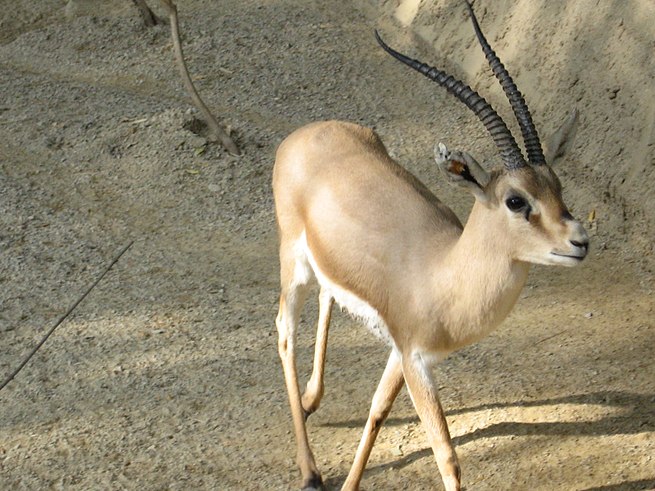Main Difference
The main difference between Gazelle and Deer is that the Gazelle is a genus of mammals and Deer is a family of mammals
-
Gazelle
A gazelle is any of many antelope species in the genus Gazella. This article also deals with the six species included in two further genera, Eudorcas and Nanger, which were formerly considered subgenera of Gazella. A third former subgenus, Procapra, includes three living species of Asian gazelles.
Gazelles are known as swift animals. Some are able to run at bursts as high as 100 km/h (60 mph) or run at a sustained speed of 50 km/h (30 mph). Gazelles are found mostly in the deserts, grasslands, and savannas of Africa; but they are also found in southwest and central Asia and the Indian subcontinent. They tend to live in herds, and eat less coarse, easily digestible plants and leaves.
Gazelles are relatively small antelopes, most standing 60–110 cm (2–3.5 ft) high at the shoulder, and are generally fawn-colored.
The gazelle genera are Gazella, Eudorcas, and Nanger. The taxonomy of these genera is confused, and the classification of species and subspecies has been an unsettled issue. Currently, the genus Gazella is widely considered to contain about 10 species. Four further species are extinct: the red gazelle, the Arabian gazelle, the Queen of Sheba’s gazelle, and the Saudi gazelle. Most surviving gazelle species are considered threatened to varying degrees. Closely related to the true gazelles are the Tibetan and Mongolian gazelles (species of the genus Procapra), the blackbuck of Asia, and the African springbok.
One widely familiar gazelle is the African species Thomson’s gazelle (Eudorcas thomsoni), which is around 60 to 80 cm (24 to 31 in) in height at the shoulder and is coloured brown and white with a distinguishing black stripe. The males have long, often curved, horns. Like many other prey species, Tommies and springboks (as they are familiarly called) exhibit a distinctive behaviour of stotting (running and jumping high before fleeing) when they are threatened by predators, such as cheetahs, lions, African wild dogs, crocodiles, hyenas, and leopards.
-
Deer
Deer (singular and plural) are the hoofed ruminant mammals forming the family Cervidae. The two main groups are the Cervinae, including the muntjac, the elk (wapiti), the fallow deer and the chital, and the Capreolinae, including the reindeer (caribou), the roe deer and the moose. Female reindeer, and male deer of all species except the Chinese water deer, grow and shed new antlers each year. In this they differ from permanently horned antelope, which are part of a different family (Bovidae) within the same order of even-toed ungulates (Artiodactyla).
The musk deer of Asia and water chevrotain of tropical African and Asian forests are not usually regarded as true deer and form their own families: Moschidae and Tragulidae, respectively.
Deer appear in art from Paleolithic cave paintings onwards, and they have played a role in mythology, religion, and literature throughout history, as well as in heraldry. Their economic importance includes the use of their meat as venison, their skins as soft, strong buckskin, and their antlers as handles for knives. Deer hunting has been a popular activity since at least the Middle Ages and remains resourceful for many families today.
-
Gazelle (noun)
An antelope of either of the genera Gazella (mostly native to Africa) or Procapra (native to Asia), capable of running at high speeds for long periods.
-
Deer (noun)
A ruminant mammal with hooves of the family Cervidae, or one of several similar animals from related families of the order Artiodactyla.
-
Deer (noun)
One of the smaller animals of this family, distinguished from a moose or elk.
“I wrecked my car after a deer ran across the road.”
-
Deer (noun)
The meat of such an animal; venison.
“Oh, I’ve never had deer before.”
-
Deer (noun)
An animal, especially a quadrupedal mammal, as opposed to a bird, fish, etc.
-
Gazelle (noun)
a small, slender antelope that typically has curved horns and a fawn-coloured coat with white underparts, found in open country in Africa and Asia.

